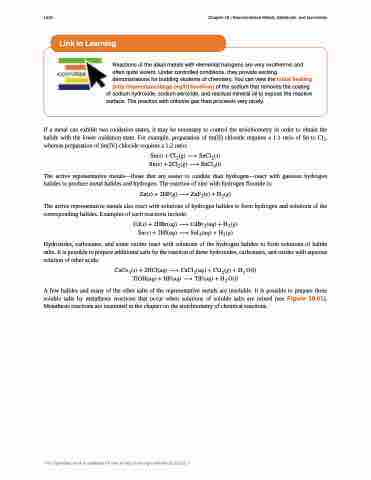Page 1042 - Chemistry--atom first
P. 1042
1032
Chapter 18 | Representative Metals, Metalloids, and Nonmetals
Link to Learning
Reactions of the alkali metals with elemental halogens are very exothermic and often quite violent. Under controlled conditions, they provide exciting demonstrations for budding students of chemistry. You can view the initial heating (http://openstaxcollege.org/l/16sodium) of the sodium that removes the coating
of sodium hydroxide, sodium peroxide, and residual mineral oil to expose the reactive surface. The reaction with chlorine gas then proceeds very nicely.
If a metal can exhibit two oxidation states, it may be necessary to control the stoichiometry in order to obtain the halide with the lower oxidation state. For example, preparation of tin(II) chloride requires a 1:1 ratio of Sn to Cl2, whereas preparation of tin(IV) chloride requires a 1:2 ratio:
����� � ������ � �������� ����� � ������� � ��������
The active representative metals—those that are easier to oxidize than hydrogen—react with gaseous hydrogen halides to produce metal halides and hydrogen. The reaction of zinc with hydrogen fluoride is:
����� � ������ � ������� � �����
The active representative metals also react with solutions of hydrogen halides to form hydrogen and solutions of the
corresponding halides. Examples of such reactions include:
����� � �������� � ��������� � ����� ����� � ������� � �������� � �����
Hydroxides, carbonates, and some oxides react with solutions of the hydrogen halides to form solutions of halide salts. It is possible to prepare additional salts by the reaction of these hydroxides, carbonates, and oxides with aqueous solution of other acids:
�������� � �������� � ��������� � ������ � �� ���� �������� � ������ � ������� � �� ����
A few halides and many of the other salts of the representative metals are insoluble. It is possible to prepare these soluble salts by metathesis reactions that occur when solutions of soluble salts are mixed (see Figure 18.61). Metathesis reactions are examined in the chapter on the stoichiometry of chemical reactions.
This OpenStax book is available for free at http://cnx.org/content/col12012/1.7


